![]()
![]()
![]()
Use LEFT and RIGHT arrow keys to navigate between flashcards;
Use UP and DOWN arrow keys to flip the card;
H to show hint;
A reads text to speech;
23 Cards in this Set
- Front
- Back
|
Market equilibrium |
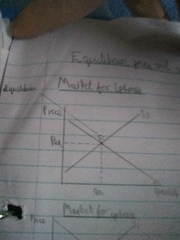
When quantity supplied = quantity demanded at the current market price. A market will naturally gravitate to the equilibrium point through price fluctuations. |
|
|
Market shortage |
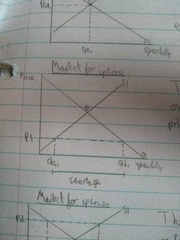
When the market price is below the equilibrium price, so demand outstrips supply, resulting in a shortage. Suppliers will raise the price.and increase quantity supplied. The higher price will also cause the quantity demanded to fall. This occurs until the equilibrium price has been reached. |
|
|
Surplus |
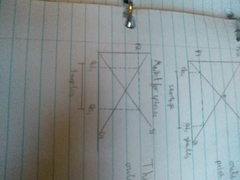
When the market price is above the equilibrium price and so supply outstrips demand, causing a surplus. Suppliers will lower their prices and decrease the quantity supplied. The lower price will also cause the quantity demanded to rise. This occurs until the equilibrium price is reached. |
|
|
Market price |
The economic price at which goods and services are offered in the marketplace. |
|
|
Equilibrium price |
The market price when quantity supplied = quantity demanded. The point where the demand and the supply curves intersect. |
|
|
Price ceiling |

A price ceiling is the maximum price a seller is allowed to charge for a good or service. It must be set below the equilibrium price to be effective. |
|
|
Downsides of price floors: |
1) Producers worldwide will be poorer as they do not have a price floor and have to compete with increased imports. 2) Established producers may see increased competition as more firms join the market. 3) Governments will have to pay out, either to buy surplus products or pay the difference between Pe and Pf. 4) The quality of the product may drop, even as the price increases. |
|
|
Price elasticity of demand |
The extent to which a change in a product's price affects quantity demanded. |
|
|
Price Elasticity of Demand = |
PED = (Actual change in QD ÷ original QD) ÷ (actual change in price ÷ Original price) |
|
|
Demand is 'price inelastic' when... |
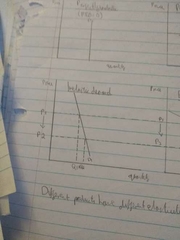
The % change in quantity demanded is less than the % change in price. Demand very responsive to changes in price. (Value is between 0 and 1). |
|
|
Demand is 'unitary' when |
The % change in quantity demanded equals the % change in price. |
|
|
Demand is 'price elastic' when... |
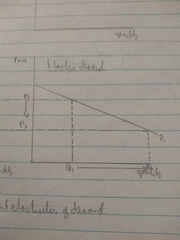
The % change in quantity demanded is more than the % change in price. Demand is very responsive to changes in price. (Values are from 1 to infinity). |
|
|
Perfectly inelastic demand |

A change in price has no effect on quantity demanded (value given as 0). |
|
|
Perfectly elastic |
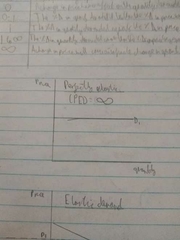
A change in price will cause an infinite change in quantity demanded. (Value given as infinite). |
|
|
Factors affecting PED |
1) Availability of substitutes: if a good has several close substitutes, demand will be more elastic as people can simply switch to an alternative good. 2) Time period: a longer time period means demand becomes more price elastic as alternatives are developed and habits change. 3) Necessities: Necessities have more inelastic demand, as they are essential, and so demand will not greatly decrease with an increased price. 4) Proportion of total income: when spending on a product accounts for a relitavely small proportion of your total income demand will tend to be more elastic as people accept larger % increases in price. |
|
|
Why does PED matter? |
When demand is inelastic, price and revenue move in the same direction (e.g. a rise in price will cause a rise in revenue). However, when demand is elastic, price and revenue move in opposite directions. |
|
|
What does Price Elasticity of supply measure? |
The responsive of quantity supplied to a change in price. |
|
|
PES = ? |
PES = (Change in quantity supplied ÷ original quantity supplied) ÷ (Change in price ÷ original price) |
|
|
Supply is inelastic when... |
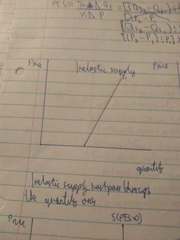
The % change in price is greater than % change in quantity supplied. (Values 0 to 1). An inelastic supply curve must pass through the X axis. |
|
|
Supply is unitary when... |
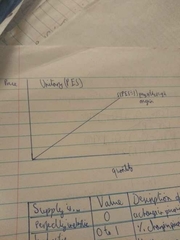
% change in price equals the % change in quantity supplied. (Value = 1). A unitary supply curve must pass through the origin. |
|
|
Supply is elastic when... |
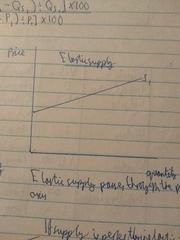
% change in price is smaller than % change in quantity supplied (values 1 to infinity). An elastic supply curve must pass through the price axis. |
|
|
Perfectly inelastic PES and perfectly elastic PES look like... |
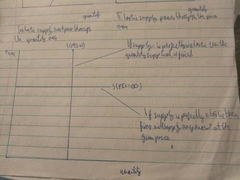
|
|
|
What are the determinants of PES? |
1) Producer substitutes: Goods which a producer can easily produce as alternatives to their current product. If there are a lot of them, supply will be more elastic. 2) Time: the shorter the time period, the more difficult it is for firms to switch from making one product to another. Shorter time periods mean more inelastic supply. 3) Spare capacity: the more spare capacity a producer has, the easier it is to increase output if the price rises. The higher than spare capacity, the more elastic supply. 4) Number of producers: The more producers there are, the easier it should be for the producers to raise output. 5) Nature of product: If the product can be stored, supply will be more elastic. |

